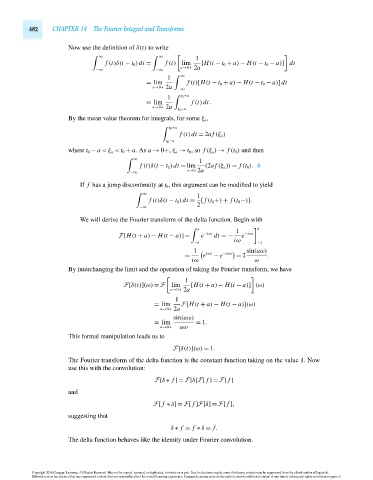Page 502 - Advanced engineering mathematics
P. 502
482 CHAPTER 14 The Fourier Integral and Transforms
Now use the definition of δ(t) to write
1
∞ ∞
f (t)δ(t − t 0 )dt = f (t) lim [H(t − t 0 + a) − H(t − t 0 − a)] dt
a→0+ 2a
−∞ −∞
1 ∞
= lim f (t)[H(t − t 0 + a) − H(t − t 0 − a)]dt
a→0+ 2a
−∞
1 t 0 +a
= lim f (t)dt.
a→0+ 2a
t 0 −a
By the mean value theorem for integrals, for some ξ a ,
t 0 +a
f (t)dt = 2af (ξ a )
t 0 −a
where t 0 − a <ξ a < t 0 + a.As a → 0+, ξ a → t 0 ,so f (ξ a ) → f (t 0 ) and then
∞ 1
f (t)δ(t − t 0 )dt = lim (2af (ξ a )) = f (t 0 ).
a→0 2a
−∞
If f has a jump discontinuity at t 0 , this argument can be modified to yield
∞ 1
f (t)δ(t − t 0 )dt = [ f (t 0 +) + f (t 0 −)].
2
−∞
We will derive the Fourier transform of the delta function. Begin with
a 1 a
F[H(t + a) − H(t − a)]= e −iωt dt =− e −iωt
−a iω −1
sin(aω)
1 iaω −iaω
= e − e = 2 .
iω ω
By interchanging the limit and the operation of taking the Fourier transform, we have
1
F[δ(t)](ω) = F lim [H(t + a) − H(t − a)] (ω)
a→0+ 2a
1
= lim F[H(t + a) − H(t − a)](ω)
a→0+ 2a
sin(aω)
= lim = 1.
a→0+ aω
This formal manipulation leads us to
F[δ(t)](ω) = 1.
The Fourier transform of the delta function is the constant function taking on the value 1. Now
use this with the convolution:
F[δ ∗ f ]= F[δ]F[ f ]= F[ f ]
and
F[ f ∗ δ]= F[ f ]F[δ]= F[ f ],
suggesting that
δ ∗ f = f ∗ δ = f.
The delta function behaves like the identity under Fourier convolution.
Copyright 2010 Cengage Learning. All Rights Reserved. May not be copied, scanned, or duplicated, in whole or in part. Due to electronic rights, some third party content may be suppressed from the eBook and/or eChapter(s).
Editorial review has deemed that any suppressed content does not materially affect the overall learning experience. Cengage Learning reserves the right to remove additional content at any time if subsequent rights restrictions require it.
October 14, 2010 16:43 THM/NEIL Page-482 27410_14_ch14_p465-504

